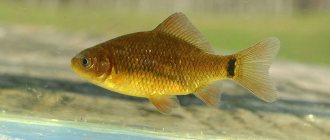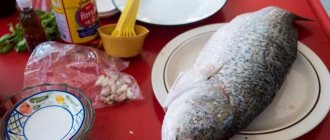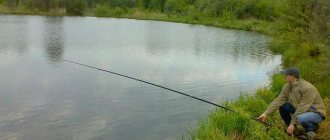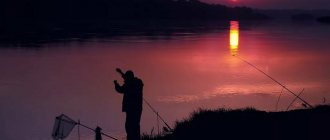Such uncontrolled fishing of this fish led to the fact that by 2006-2007 the number of this fish had decreased significantly and it was almost impossible to find it in its usual habitat. As a result, shamaika was included in the Red Book. Despite the protective actions of the law, poachers and local fishermen still continue to fish for this rare and tasty fish.
Why was shamaika called the “royal fish”?
The fish belongs to the family of carp fish species and has a number of individual characteristics, which makes it easy to distinguish it from its relatives. To understand how it differs from other representatives of the carp family, you should pay attention to some features. For example:
- The size of individuals and their weight depend on the habitat: the Black Sea shamaika is larger in size compared to the Caspian one. In its natural habitat, it can grow up to 30 cm in length and weigh up to 900 grams. As a rule, you come across individuals that weigh no more than 300 grams. Larger specimens are already considered trophy specimens.
- The body of the shamaika has an oblong, elongated shape, which is not traditional for the family of carp fish species. It is covered with small scales with a silvery tint.
- The lower jaw is somewhat thickened and pushed forward, which indicates serious differences between representatives of the carp family.
- The head, at the same time, is small in size in relation to the body and is painted in a dark color, with a characteristic bluish tint.
- The shamaika's back is gray in color, and its belly is lighter, with a silvery tint.
- The fins of this fish are gray. On the anal and dorsal fin there is a small border, painted black.
- The shamaika's eyes are silver in color, and in their upper part there is a characteristic black dot.
What does shamaika fish look like and where is it found?
The name of the fish shamaya, shemaya, or shamaika came from ancient Persia from the word “shah-mai”, which translates as “royal fish”. In other places it is called selyava. Belongs to the carp family. Its meat is fatty and tender. It has excellent taste and is considered an expensive delicacy, which is why it got its name.
Shamaya is an endangered species and is listed in the Red Book of Russia.
What does a shamaika look like?
- Shamaya is not large . Its weight ranges from 200-300 to 600-700 grams. The body is oblong, elongated, from 20 to 30 cm long. Large specimens are rare.
- The body is covered with small scales.
- The sides and belly of the shamaika are silvery-white . The back and upper part of the head are darker, with a bluish or greenish tint.
- The fins of this fish are transparent , the base is pink or orange. The caudal fin has a dark-colored border.
- The head is small in relation to the body . The lower jaw protrudes significantly forward. The eyes are silver, with a large black dot.
There is a similarity with bleak.
You can distinguish by several characteristics:
- the shemika is larger, the body is more elongated with small scales,
- the lower jaw of the bleak is also elongated, but it is turned upward and fits into a recess on the upper jaw.
In another article on our website, you can see what pollock fish looks like.
Habitats of king fish
Based on their habitat, fish are divided into two forms: residential and semi-anadromous.
- The residential form includes those that constantly live in one place . There are shamaikas that constantly live in rivers, others live in low-salt areas of the seas.
- The largest numbers are in the semi-anadromous form . These are the shemai that spend most of their time in the sea, and only rise into the rivers to spawn.
Residential and migratory species differ in taste. But there is no consensus which one is tastier.
The main part of these fish lives in the basins of the Azov, Caspian and Black Seas. She prefers the southern parts. A large number of individuals of this species were discovered in the Aral Sea, in Turkestan.
- From the Sea of Azov, shamaya comes out to spawn mainly in the Kuban, occasionally in the Don or Donets.
- From the Caspian - to Terek, Kura. In the Volga, individuals of this species are found, but rarely.
- From the Black Sea, fish go to spawn in the Dnieper, Dniester and small rivers of the Crimean Peninsula.
Shamayki prefer fast currents. This explains the fact that they are found more often in the Crimean rivers, in the Kuban, Terek and Kura than in others. They rarely go high in rivers and live closer to the sea.
Here you can read where grenadier is found.
How does shamaika reproduce?
Males of shamaika reach sexual maturity at 2-3 years, females somewhat later. They are ready to spawn by 3-4 years. Basically, these fish spawn 2-3 times during their lives; rarely, some individuals can produce offspring up to 5 times. During spawning, males develop tubercles on their heads - spines. In females, a tubercle forms on the lower jaw.
At the end of spawning, the tubercles disappear.
The shamaika spawning site is chosen to be shallow, 25-40 cm from the surface of the water to the bottom. The river in this place is rocky, without algae and silt, with clear water. A prerequisite for spawning is a fast current.
Shamaikas spawn and spawn only late in the evening, when it gets dark or at night. The caviar is very small. The current of the river carries it under the stones and sticks to them from the bottom side. The larvae hatch after 3-5 days and grow slowly in dark places on the bottom. Their growth lasts about a year.
After a year, the yolk sac, through which the fry receives food, resolves. Small fish, weighing no more than 1 gram, slide downstream to the sea. In the sea they begin to grow rapidly.
Spawning in shamaikas occurs at different times of the year.
It depends on where you live:
- In Kuban, the spawning period is the longest. It lasts from late September to March.
- In Kuru and Terek - from November to December.
- In the Dnieper, shamaikas spawn in April and March.
- In the Don - in the very early spring, as soon as the ice breaks up.
Shamaykas enter rivers in small flocks. One flock follows immediately after another. It has been noticed that in flocks the number of females prevails over the number of males. The fish do not linger at the spawning site, but immediately return to the sea.
Shamaik lifestyle
How individuals of this fish species live has not been studied in detail.
Shemai live in flocks and prefer clean and oxygen-rich waters.
It is known that at night they rise to the upper layers of the sea , and during the day they sink closer to the bottom.
Shamayka is a predator. It feeds on zooplankton, insects and their larvae. Occasionally eats fry.
Penalty for catching shemai
Due to the development of human economic activity, access to many reservoirs where spawning usually took place was closed. The number of individuals of this fish species has decreased sharply.
In Russia, the Azov-Black Sea Shemaya is listed in the Red Book in the second category. It is recognized as a subspecies whose numbers are rapidly declining and may disappear without emergency measures.
According to Article 27.1 of the Federal Law dated December 20, 2004 No. 166-FZ “On Fisheries and Conservation of Aquatic Biological Resources,” fishing for shemaya is prohibited.
An administrative fine is imposed on a fisherman whose catch includes shemaika, in accordance with Article 8.37 of the Administrative Code, paragraph 2.
- For an individual from 1000 to 2000 rubles.
- For officials from 10,000 to 15,000 rubles.
- For legal entities from 100,000 to 200,000 rubles.
In any of these cases, confiscation of the catch, vessel and fishing gear may be applied.
To replenish the numbers of this species, fish hatcheries have been created to breed shemaya. Every year, larvae and juveniles are released into rivers. If the activities of nurseries help increase the share of these rare fish in water bodies, then the shemaya will be excluded from the Red Book.
Source: https://superulov.com/lovlya-ribi/shamajka.html
Habitats
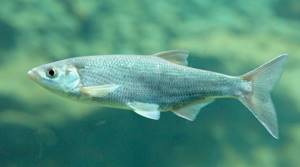
The places where shamaika is found can be listed on one’s fingers.
You can actually meet her:
- In rivers that flow into the Black, Azov or Caspian Seas. In other words, shamaika is a prominent representative of the Black and Caspian Sea basins. At the same time, it does not rise high against the current, but prefers to be in close proximity to sea basins.
- In the Aral Sea, where the largest populations of shamaika live.
- In the coastal zones of the Caspian and Azov seas.
- Kuban, where it falls directly into the Sea of Azov, and this breed is also found in the waters of the Don.
- At the mouths of the Terek and Kura rivers.
- In the Black Sea, although the number of individuals here is limited. From the Black Sea, shamaika easily moves to the Dnieper and Dniester rivers, where it is also possible to meet this unique fish.
- Very small populations occur within the territories of other European countries. As a rule, this is the Danube River and some Bavarian reservoirs.
Lifestyle: nutrition and reproduction
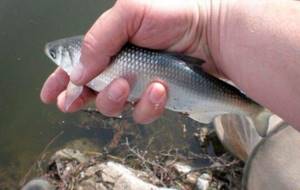
The behavior of the shamaika directly depends on its habitat, which is determined both by its geographical location and the availability of food supply. For example:
- On the territory of Russia, it practically does not leave sea waters. She leaves them only during spawning periods, and then she does not rise very high against the current.
- The shamaika, which lives in the reservoirs of Bavaria, prefers to be near reservoirs that have clean water and are characterized by a rocky bottom structure. This is due to the fact that this fish prefers to inhabit reservoirs with clean water enriched with oxygen.
- Almost all populations of shamaika prefer water bodies with rapid currents. In this regard, it cannot be found in such large rivers as the Volga. In the Dnieper it is found, but in small quantities. Rivers such as the Kuban or Terek are more suitable for her. Here the shamaika population is quite high.
The shamaika is an omnivorous, although not a large fish, more predatory than peaceful. Its diet consists of plankton, as well as all kinds of insects and their larvae, including crustaceans. Already quite adult individuals can hunt fry. Therefore, older individuals should be classified as predators. Particular attention should be paid to the reproduction process, which has certain features. For example:
- After 2 years of life, the shamaika is ready for reproduction.
- Spawning occurs in warm water, for which it moves from seas to rivers.
- Spawning occurs exclusively at night.
- Places for spawning are rifts where there is a fast current, and the bottom in these places is covered with pebbles or stones.
- After spawning, the fish migrate to their usual habitats, and after 3-4 days the first fry appear.
- For 1 year after birth, young shamaika prefer to stay in rivers. After 1 year, the “trifle” moves to the sea, where its growth accelerates greatly.
Dialogues about fishing -128- Rostov region, Shemaya.
Features of spawning
Sexual maturity of shamaika fish occurs at the age of two years. Spawning occurs in warm water at night or at dusk; for this, it enters places where freshwater rivers rifts, where rapid currents and rocky bottoms predominate. flow,
The spawning process takes place in an organized manner. A small flock stands motionless for some time with their heads down against the current, suddenly makes a sharp jerk forward and with energetic movements of the tail frees itself from eggs and milt. Having finished spawning, they retreat together into the sea, and another group takes this place, then a third.
Interesting fact! The fertility of various species in different river waters ranges from 2.6 to 23.5 thousand eggs.
Small, inconspicuous eggs are fixed on the rocky bottom, in plants, and after 3-4 days the larvae appear. During the year, juveniles live in spawning areas for a long time. Having reached a weight of one gram, it goes to sea.
Shamayka fish spawn in different regions at different times:
- in Kuban - in autumn,
- Don shamaika - in early spring, sometimes in late winter.
- in Terek - strictly in December,
- in Bavaria - in May. That's why the fish here is called May whitefish.
Interesting fact! Shamaykas spawn 2-3 times during their life, only some are lucky enough to give birth to offspring up to 5 times.
Fishing for shamaika
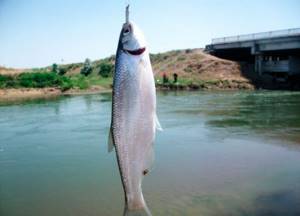
Since shamaika is more of a predatory fish, you need to choose appropriate baits. When going fishing, it is better to stock up on several types of bait and in practice decide on the most catchy one. Since adult individuals prefer food of animal origin, it is better to take bait of an animal nature with you in order to automatically cut off smaller individuals.
Basically, when catching shamaika, fishermen use:

- Bloodworm.
- Earthworms or earthworms.
- Maggot.
- Kuznechikov.
- Larvae of various insects.
- Small crustaceans.
Shamaya does not particularly select baits and, with a certain activity, reacts equally to all of the above. Many anglers use several different baits on their hooks at the same time. The result is a so-called sandwich, which significantly increases fishing performance.
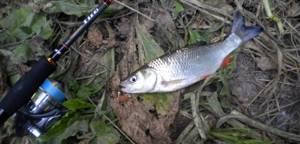
In this case, you should pay attention to the following factors:
- Active biting for shamaika begins in the middle or end of April. At the same time, the choice of a promising location plays an important role. They are caught mainly with a regular float fishing rod, although the use of a spinning rod also bears fruit.
- For greater efficiency, it is better to feed the fishing spot. This is the only way to interest the fish and keep it at the fishing point. Bait is prepared based on water from the reservoir where the fishing process takes place. Corn grits, cake, any porridge or bran are suitable for preparing bait. We should not forget about store-bought bait, although this approach will cost a little more.
- Before you start fishing, you will have to determine on what horizon the fish is located. Basically, she prefers to be at the very bottom, but sometimes she rises closer to the surface.
- Larger individuals do not rise closer than 1 meter to the surface of the water. When catching trophy specimens, this feature must certainly be taken into account. But a small shamaika may be located right at the surface.
- A fishing line with a thickness of 0.2-0.4 mm, with a smaller leash, is suitable for fishing. If the fishing area is clean, without underwater surprises, then you can refuse the leash.
- The hook selected is no larger than number 6.
- The shamaika bites energetically and often, which cannot but please the angler. The float, however, is rarely completely immersed in water. You should not delay hooking, otherwise the fish may feel resistance and refuse further bites. The very first bite should be accompanied by a hook.
Dialogues about fishing 2013. Azerbaijan Part 1. Shemaya.
Shamayka fish photo - appearance and habitat, punishment for poaching, video
- appearance and habitats, punishment for poaching, video
- Shemaya fish – photo, description, habitat, nutrition, population
- Black Sea-Azov shemaya - Wikipedia Measures to restore numbers[edit | edit code]
- Reproduction
- Reproduction
Shamayka is a tasty fish, but rare. Therefore, it is very expensive, and catching it is punishable by law.
Shamayka - tasty fish, but rare
material
What is shamaika
It belongs to the genus of ray-finned fish of the carp family. Lives in fresh moving water. Its area of residence is the rivers of the Azov-Black Sea basin, sometimes the Sea of Azov. The shape of the shamaika is elongated, covered with small silvery scales. The body is flat, low, compressed laterally. The head shimmers with silvery-bluish tints. The back is shiny, dark green, the sides are light, also shiny.
The front fins have an orangish tint. The dorsal fin is slightly shifted back. The posterior one is located on the abdomen immediately behind the dorsal one. All fins are gray. The lower jaw is more massive than the upper jaw. The length of an adult shemaya reaches no more than 35 cm, weighs about 600 g. In appearance, the shamaika resembles a fish fish, only a little more elongated.
We also recommend reading:
It can tolerate both fresh and salt water, as long as it is clean and rich in oxygen. It lives mainly in the seas, preferring places with rocks on the bottom. In the spring it enters freshwater rivers to spawn.
She prefers fast currents and rocky bottoms. Egg laying occurs in the dark. The eggs of shamaika are very small and unnoticeable. During spawning, the fish are very vulnerable.
Therefore, experienced poachers who know well the habits and tastes of shamaika can easily catch it.
Shamayka got its name from the Persian “shah-mai”, which is translated into Russian as “royal fish”. This is due to the taste characteristics of this fish. Shamayka has fatty, tender meat that tastes very pleasant. Therefore, its cost is high, not inferior even to sturgeon.
Another reason for the high cost of shemaya is its rarity. The fact is that the climate is changing all the time, people are polluting the seas, changing the directions of rivers. Therefore, every year the natural conditions of the Azov basin become less and less suitable for the propagation of shamaika.
This fish is so rare that even the Red Book contains it in its list of endangered animals. The delicious beauty came under protection in 2007, when it was on the verge of extinction.
Catching this valuable scaly waterfowl is prohibited by law. For single fishing there is a fine, and for mass fishing there is criminal liability.
In 2014, scientists began attempting to restore the population. For this purpose, fry are bred in artificial conditions. Every year, at least 3 million young individuals are released into the wild. But it has not yet been possible to restore sufficient numbers of the rare species due to the active activity of poachers.
https://www.youtube.com/watch?v=6K9BNIyvvX0
Therefore, the law actively persecutes not only those who catch shamaika, but also those who consume it. There are no other ways to control the ongoing catch of endangered specimens.
Catching prohibited fish
The Azov shemaya is a predator: it feeds on small fish and insects. Therefore, it is easy to catch with various baits. The following baits are used: shashel, worms, maggots, larvae, grasshoppers. Shemaya can also be caught on pieces of fry.
The forbidden delicacy is caught mainly in summer in fast-flowing rivers using a fishing rod and net. The float is a regular feather float.
The size of the catch also determines the punishment: for several carcasses a fine of several hundred thousand can be issued, and for a catch on an industrial scale - a criminal penalty in the form of imprisonment. The same applies to sellers and consumers of protected fish.
Shemaya belongs to the genus of ray-finned fish of the carp family
Shemaya is a schooling fish. Schools of shamaika almost always swim together with schools of vimba. They are also caught together. Therefore, when fishing for them, they have two hooks on a fishing rod. The lower one catches small fish, and the upper one catches a valuable species.
The Azov fish is a predator: it feeds on small fish and insects
In order not to destroy the already endangered fish, it is recommended not to catch it, but to breed it. To do this, it is enough to create a small pond on your property and release several individuals caught in the wild there. In this case, the wild population will not suffer, and a delicious delicacy will always be at hand.
Shemaya fish – photo, description, habitat, nutrition, population
Shemaya (Chalcalburnus Chalcoides) is a ray-finned fish belonging to the carp family and the genus Bleak. The schooling fish is a rare species and has a progressively declining population.
articles:
Description of Shemaya fish
Currently, several names for shemaya fish are known - “shamaya fish”, or “shamayka”, which originated from ancient Persia. The Persian name "shah-mai" was translated as "royal fish" .
Appearance
According to the shape of its body, the ray-finned shamaika fish is elongated, covered with small, silvery scales. The body of the fish is flat and low, noticeably compressed from the side.
The head is characterized by silvery-bluish tints. The back is shiny, dark green in color, the sides are in light colors, with a shine. The maximum body length of an adult is 34-35 cm.
A distinctive feature of the dorsal fin is its pronounced backward direction.
The front fins of the shamaika have an attractive orangeish tint.
The dorsal fin is characterized by some shift back, and the rear fin is located in the abdominal area, directly behind the dorsal fin. Absolutely all fins of predatory fish are grayish in color.
In its entire appearance, the small shamaya fish resembles a vimba, and the main difference is its slightly more elongated body shape.
The lower jaw of the fish is more massive compared to the upper jaw. The eyes are silver, with a small black dot at the top. The maximum average weight of an adult is about 580-650 g.
Behavior and lifestyle
The behavioral characteristics and lifestyle of individuals of this species of ray-finned fish have not been studied in detail at present. As observations show, shamaika fish belong to the schooling category, and also prefer to settle in clean and oxygen-rich waters. It has been noted that predatory representatives of the Carp family and the Bleak genus rise to the upper layer of sea water at nightfall.
! Scientists have found that the predatory shamaika, which almost always lives in the sea, is capable of entering river water exclusively for the duration of spawning.
And during the day, such fish descend closer to the bottom of an inhabited natural reservoir. Schools of the predator travel quite far from the coastline, but are sometimes able to come to a relatively close distance. The Bavarian variety lives in reservoirs with the cleanest possible water and a rocky bottom surface.
Lifespan
The exact maximum lifespan of shamaika has not currently been established, due to the lack of complete data on the predatory fish. However, according to some information, the Aral Shemaya is able to live up to the age of nine, and the average length of such an adult is approximately 30-32 cm.
Return
Range, habitats
The shamaika fish, distinguished by its pelargic lifestyle, has a rather limited distribution area . Different species of shemaya are able to live in both fresh and sea water. In the Black Sea region, the distribution area is quite wide.
For example, along the Don River, schools of fish rise and enter tributaries located upstream. There are also known cases of shamaika appearing in the Voronezh region and even slightly higher. In the Caspian Sea, the predatory representative of ray-finned fish prefers to settle in the southwestern part, and schools rarely enter the northern tributaries.
! In recent years, shemai fish are practically not found in the Dnieper. In other European countries, a representative of the carp family and the genus Bleak is known only in the waters of the Danube, and belongs to the category of very rare fish.
In the Volga River, part of the natural spawning grounds has become inaccessible to fish due to the erected and functioning hydraulic structures. However, in some reservoirs of our country sedentary forms of shamaika fish are observed.
Rare fish were artificially introduced into some reservoirs in Kalmykia and Stavropol. The shemai variety lives in small numbers in lakes in Bavaria. Relatively recently, the shemaya was also discovered in the Turkestan region, where it lives in the Ak-Darya Duman-Kul.
Return
Diet and nutrition
Shamaya is an omnivorous species of aquatic predator, therefore the basis of the diet of this fish is represented by plankton, various types of insects and their larvae, as well as crustaceans. In some cases, the shamaika is also capable of hunting fry.
Return
Reproduction of Shemaya fish
Shemaya, along with other semi-anadromous forms, spawns in fresh waters . Schools of shemai begin to move into the spawning river in the last ten days of September or early October.
The transition process lasts until January-March. In later spring, the shemaika enters a little higher into the river, where direct spawning begins.
For successful spawning, shemai require water temperatures of 18°C.
Sexually mature fish spawn between the end of May and the last ten days of July. The fertility parameters of different flocks of Shemaika in different river waters fluctuate, and can be 2.6-23.5 thousand eggs.
Shemai begin to spawn at dusk or at night, in areas with pebble and rocky soil, in the complete absence of algae and silt.
After spawning, all adult shemai fish do not linger in river waters, but immediately move towards the sea.
Quite often, predatory fish choose rifts with clear water and fast currents for spawning. As a rule, spawning occurs at a depth of 20-40 cm, and the swept eggs are carried by the current under pebbles or small stones, to which they are securely glued.
! Young shemaya fish are characterized by a rather slow development, which occurs in the river, and after about a year the shemaya moves to the sea, where growth processes accelerate.
Under favorable conditions, the larvae hatch in about three days. For a long time, the hatched larvae remain at the bottom of the reservoir, in a dark place, and then they gradually roll down the river current into sea waters.
Return
Natural enemies
The main natural enemy of shamaika is man . In the last century, the rich stocks of shemaya fish were significantly undermined as a result of the construction of power plants and uncontrolled fishing, which forced artificial breeding of this aquatic predator.
In addition to the reduction in spawning areas, the process of natural reproduction of shemaya is extremely negatively affected by pollution of water bodies, as well as significant changes in water levels in seas and rivers.
Return
Population and species status
There are about thirteen subspecies of shemaya, but only two live in Russian reservoirs: the Black Sea shamaia and the Caspian. Passage and residential forms are also distinguished. Predatory shemai have always been quite common inhabitants of the basins of the Black Sea and Azov Seas.
! Shamayka meat is very tasty and nutritious, fatty and incredibly soft, thanks to which this aquatic inhabitant has long been the basis of the fishery among local residents, as well as tourist fishermen.
The result of such active human activity was a significant reduction in population numbers, so fish are no longer often found in the natural environment. Currently, shamaika is listed in the Red Book.
However, despite all the numerous bans and penalties imposed, illegal fishing is still widespread. Among other things, industrial fishing is a criminal offense, and such offenses are punishable by a suspended or real prison sentence.
Return
Fines

Since shamaika is listed in the Red Book, there are prohibitions and penalties for catching it. For example:
- Fishing, in especially large quantities, especially with the use of nets, may entail not administrative, but criminal punishment. In this regard, you should expect to receive either a suspended or a real prison sentence.
- Catching individual individuals by ordinary citizens will entail fines ranging from 2 to 5 thousand rubles. The size of the fine depends on the number of fish caught. If females are present in the catch, the actual fine may double. At the same time, it must be taken into account that the amount of fines increases every year.
- If single specimens are caught by officials, the fine may range from 10 to 15 thousand rubles. As an example, a precedent can serve when one Krasnodar businessman was found in possession of a shamaika and he was fined for an amount significantly exceeding the indicated figures.
Nature conservation
Fishing for shamaika is currently a very, very expensive activity - due to the rapid decline in numbers, it is included in the Red Book of Russia, as well as some regions. Thanks to its tender meat, it has long been the main target of fishing for both local residents and fishing enterprises, as well as tourists. For this reason, by 2007, its population had declined so much that the fish practically ceased to be found in its natural habitat, where it was previously widespread.
After that, its fishing was prohibited, fines for its illegal catch amounted to 2 thousand rubles per head, and for catching in large quantities it became quite possible to face criminal prosecution. However, quite active fishing continues to this day, despite laws and prohibitions. The reason for this is its high demand on black markets, where its cost sometimes exceeds the price of sturgeon.
Since 2014, attempts have been made to restore the population of this valuable fish, for which purpose in the Rostov region, in specialized nurseries, fry were bred, which were subsequently released into natural habitats. In 2014, their number was 3 million and has continued to grow since then.
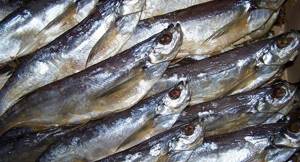
To catch the royal fish, a simple fisherman will have to pay from two thousand rubles per head. In the case of using nets and other prohibited gear to catch large quantities of shamaika, even an individual may face a real prison sentence.
Despite the fact that fines for legal entities can exceed a million rubles, poaching of this fish has not yet been defeated.
